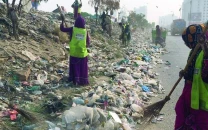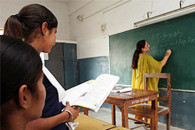Whither education ‘emergency’ in Sindh?
Little headway made despite billions injected into public education sector

Little headway made despite billions injected into public education sector. PHOTO: AFP
Over nine million children are enrolled in schools and religious seminaries across the province, according to statistics released by the school education and literacy department’s Reform Support Unit.
Of these, 47% are enrolled in public educational institutions while 36% study at private establishments. Another 13% go to other public schools. The remaining are enrolled in religious seminaries. A 2% rise has been recorded in school enrolment with the addition of nearly 84,000 students among those enrolled at public schools, according to a Sindh government report.
On October 4, 2017, Chief Minister Murad Ali Shah was informed by the school education department that nearly 56% of Sindh’s children of school-going age were deprived of any form of education.
Corresponding figures for Punjab and Balochistan stand at 43.9% and 69.5% respectively. In Islamabad Capital Territory (ICT), only 1% of children remain out of school. In Khyber-Pakhtunkhwa (K-P), 35.9% children of school- going age lack access to education.
The chief minister was informed that of the 11,991,067 children in Sindh, only 5,327,706 were receiving education. The province’s net enrolment rate stands at 61% while over 12% children dropped out following the completion of primary education. Of the 42,383 public schools in the province, 3,172 are not functioning, he was informed.
'Stop tinkering with education in Sindh'
Flawed budget estimates and delayed disbursement of funds constitute formidable challenges when it comes to revamping education standards in Sindh, the report reads. Poor access to drinking water, paucity of toilets, intermittent power outages, missing boundary walls, low quality of textbooks and poor teacher training exacerbate the students’ woes.
Of the 42,383 public schools in the province, 16,359 lack boundary walls, 13,696 do not have toilets and 23,228 and 18,120 lack access to power and running water respectively. A 2017 survey conducted by the engineering department revealed the structures of 6,157 schools across the province were derelict.
Little headway has been made despite billions of rupees being pumped into the sector, according to School Education Secretary Iqbal Durrani. The multi-billion Annual Development Programme supplemented by school specific and consolidation budgets have been financed by loans and grants from a myriad of organisations to ensure the provision of basic amenities to schools. Prominent among these organisations are USAID, the European Union and the World Bank.
89.9% of Sindh’s schools only offer primary education
Nearly 7,000 educators have been inducted over the last 10 years to enhance the standard of education. Of these, 6,000 junior school teachers have been hired to teach English, maths and science. Over 1,000 principals have also been hired. Tens of millions have been spent on organising pre-employment tests for teachers.
Of the 606 government schools in Karachi’s District Central, 78 lack boundary walls, 108 toilets, 160 access to power and 101 running water.
In District East’s 278 government schools, 27 lack boundary walls, 21 toilets, 47 access to power and 52 running water.
Of 663 government schools in District Malir, 133 lack boundary walls, 187 toilets, 358 access to power and 315 running water.
In District Korangi, 28 of 411 government schools lack boundary walls, 63 toilets, 197 access to power and 108 running water.
In District West, of the 569 government schools, 56 lack boundary walls, 105 toilets, 232 access to power and 201 running water.
Of 330 schools in District South, 28 lack boundary walls, 21 toilets, 31 access to power and 49 running water.
In Hyderabad, 121 of 868 government schools lack boundary walls, 123 toilets, 234 electricity and 264 running water.
Of 1,998 Mirpurkhas government schools, 1,027 lack boundary walls, 691 toilets, 1,205 access to power and 1,062 running water.
In Thatta, 698 of 1,282 government schools lack boundary walls, 480 toilets, 1,062 access to power and1,010 running water.
Of 1,187 Sukkur government schools, 350 lack boundary walls, 292 toilets, 449 access to power and 317 running water.
In Larkana, 157 of 1,158 government schools lack boundary walls, 184 toilets, 359 access to power and 204 running water.
Of 2,361 Shaheed Benazirabad government schools, 697 lack boundary walls, 848 toilets, 985 access to power and 674 running water.



















COMMENTS
Comments are moderated and generally will be posted if they are on-topic and not abusive.
For more information, please see our Comments FAQ